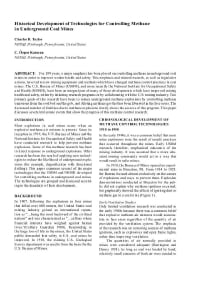Mining Publication: Historical Development of Technologies for Controlling Methane in Underground Coal Mines
Original creation date: January 2010
Authors: CD Taylor, C� Karacan
NIOSHTIC2 Number: 20037777
Extracting the Science: A Century of Mining Research. Brune JF, ed., Littleton, CO: Society of Mining, Metallurgy, and Exploration, 2010 Jan; :478-487
For 100 years, a major emphasis has been placed on controlling methane in underground coal mines in order to improve worker health and safety. This emphasis and related research, as well as legislative actions, have led to new mining equipment and methods which have changed methane control practices in coal mines. The U.S. Bureau of Mines (USBM), and more recently the National Institute for Occupational Safety and Health (NIOSH), have been an integral part of many of these developments which have improved mining health and safety, either by initiating research programs or by collaborating with the U.S. mining industry. Two primary goals of this research have been to reduce underground methane explosions by controlling methane emissions from the coal bed and the gob, and diluting methane gas that has been liberated in the face areas. The decreased number of fatalities due to methane explosions clearly shows the success of this program. This paper discusses several milestone events that show the progress of this methane control research.

NIOSHTIC2 Number: 20037777
Extracting the Science: A Century of Mining Research. Brune JF, ed., Littleton, CO: Society of Mining, Metallurgy, and Exploration, 2010 Jan; :478-487